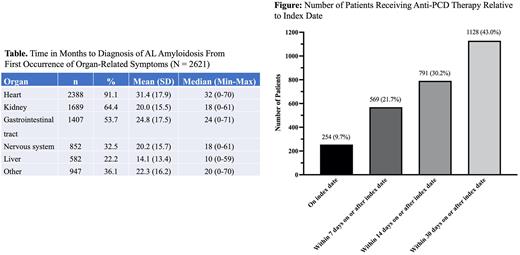Abstract
Background: Light-chain (AL) amyloidosis is a rare, progressive, systemic disease caused by plasma cell dyscrasia (PCD) and results in significant morbidity and mortality. Delays in diagnosis have been reported mainly due to nonspecific symptoms and heterogeneity in patients' clinical presentation. Anti-PCD therapy should be initiated immediately upon diagnosis to achieve a favorable hematologic response and deep organ response to improve overall survival. The goal of this analysis was to understand the path to diagnosis and the treatment patterns around the time of diagnosis using real-world data in a current population with AL amyloidosis.
Methods: A retrospective cohort study of adults (age ≥18 years) with AL amyloidosis was conducted using Komodo Health US claims data (January 2015-January 2021). Patients with ≥24 months' continuous coverage from the first claim of any condition to the date of first diagnosis of AL amyloidosis (index date; ICD-10: E85.81) and follow-up ≥6 months postdiagnosis were included. Results are reported using descriptive statistics. Patients were grouped according to organ in which the symptoms were primarily experienced.
Results: A total of 2621 patients were identified (56% male; mean age, 65.6 years) who met the inclusion criteria. More than 91% of patients reported experiencing cardiac symptoms prior to diagnosis and the median time to diagnosis for this group was 32 months, the longest of any patient group (Table). Diagnoses of AL amyloidosis on the index date were most frequently made by internal medicine (20%) or a hematologist/oncologist (19%). The specialties most frequently diagnosing AL amyloidosis as the primary diagnosis on the index date were hematology/oncology (22%) and oncology/medical (20%). Hematology/oncology was the most common specialty visited by patients on the index date and within 1- and 3-months prior to diagnosis but was not one of the top 6 specialties visited within 6- and 12-months prior to diagnosis. The top 6 specialties for which services were rendered within 6- and 12-months prior to the index date were Internal Medicine, Diagnostic Radiology, Cardiology, Pathology, Emergency Medicine, and Family Practice. Despite the prevalence of cardiac symptoms, only 10% of patients had AL amyloidosis diagnosed by cardiologists.
Anti-PCD treatment was initiated on the same date as diagnosis for 254 (9.7%) patients and within 30 days of diagnosis for 1128 (43%) patients (Figure). Cyclophosphamide-bortezomib-dexamethasone (CyBorD) was the most common treatment on the index date, and within 7-, 14-, and 30-days of diagnosis. Higher proportions of patients with cardiac symptoms received CyBorD, prednisone, and doxycycline than those without cardiac symptoms, whereas higher proportions of patients without cardiac symptoms received daratumumab than those with cardiac symptoms. The median time from index date to first daratumumab treatment was 131 days, and the median duration of daratumumab treatment was 168 days. The proportion of patients receiving daratumumab increased and the time from index date to daratumumab treatment initiation decreased each successive year.
Conclusions: These data suggest a need for greater awareness and understanding of presenting symptoms to facilitate earlier diagnosis of AL amyloidosis. Anti-PCD treatment was initiated for almost half the patients within 1 month of the index date (first diagnosis of AL amyloidosis). The time from diagnosis to initiation of daratumumab treatment is decreasing over time, most likely due to approval of daratumumab and increased awareness of AL amyloidosis. There is still a lag time between diagnosis and initiation of treatment. It is essential that treatment is started as quickly as possible. Therapies under development that decrease amyloid burden may contribute to improving patient survival and outcomes.
Disclosures
Catini:Alexion, AstraZeneca Rare Disease: Current Employment. Doan:Alexion, AstraZeneca Rare Disease: Other: Contract work. Evans:Alexion, AstraZeneca Rare Disease: Current Employment. Rava:Alexion, AstraZeneca Rare Disease: Other: Contract work. Defay:Alexion, AstraZeneca Rare Disease: Current Employment. Del Angel:Alexion, AstraZeneca Rare Disease: Current Employment. Teynor:Alexion, AstraZeneca Rare Disease: Current Employment. Quarta:Alexion, AstraZeneca Rare Disease: Current Employment. Maurer:Alexion, AstraZeneca Rare Disease: Consultancy. Lousada:Alexion, AstraZeneca Rare Disease: Speakers Bureau.
Author notes
Asterisk with author names denotes non-ASH members.


This feature is available to Subscribers Only
Sign In or Create an Account Close Modal